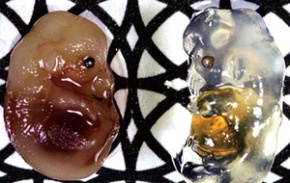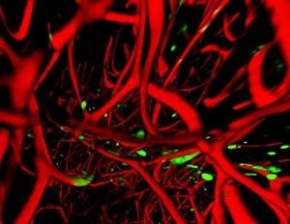Who needs an invisibility cloak when you can be transparent? Researchers in Japan recently developed a chemical reagent that turns biological tissue transparent, opening doors to optical imaging techniques and avenues of research that scientists have long only dreamed of. And speaking of dreaming — if you’re going to start turning body parts transparent, where better to start than the brain?
What if you could dissect an organism without so much as picking up a scalpel? For years, researchers have used animals like zebrafish — which are naturally transparent at the embryological stage of development, and were recently genetically engineered to remain transparent through adulthood — to do just that. But for other model organisms, like mice and rats, scientists have always had to get at their insides the old fashioned way: by cutting them up.
Slicing and dicing is necessary because modern techniques for looking at the insides of an organism can’t see deep enough to be of any real use; the tendency for tissue to scatter light, for instance, keeps modern optical methods of observation from probing deeper than 1mm into biological matter.
But all that is about to change. Take a look at the image pictured here. The object on the right may look like a pineapple gummi bear, but it’s actually a mouse embryo that’s been treated with a new chemical reagent that turns biological tissue transparent. Compare it to the embryo on the left, and you’ll get a sense of why scientists are heralding this discovery as a revolution in the field of optical imaging.
The reagent, known as Scale, was developed by a group of scientists from Japan’s RIKEN Brain Science Institute, and the team has already used it to study neurons in the brains of mice at unprecedented levels of detail. See, what’s really impressive about Scale is that it not only renders tissue transparent, it manages to do so without interfering with fluorescent labels and signaling. (Fluorescent labeling is a well-establish imaging technique that allows scientists to genetically alter proteins of interest so that they light up with a specific color when exposed to certain.)
The researchers’ findings, which are documented in the latest issue of Nature Neuroscience, demonstrate their ability to visualize in three dimensions the intricate networks of neurons and blood vessels in the brains of embryonic mice at sub-cellular resolution, like the neural stem cells (green) and blood vessels (red) pictured here.
This latest research uses Scale to visualize fluorescently-labeled brain samples, but the researchers say that their reagent will prove invaluable in the study of other tissues, as well. Dr. Atsushi Miyawaki, who led the RIKEN research team, says they envision using Scale on organs like the heart, muscles, and kidneys, and even on tissues from other organisms, including primates and humans.
And while the reagent in its current form is too powerful to use on living organisms, Miyawaki says that could change:
We are currently investigating another, milder candidate reagent which would allow us to study live tissue in the same way, at somewhat lower levels of transparency. This would open the door to experiments that have simply never been possible before.
